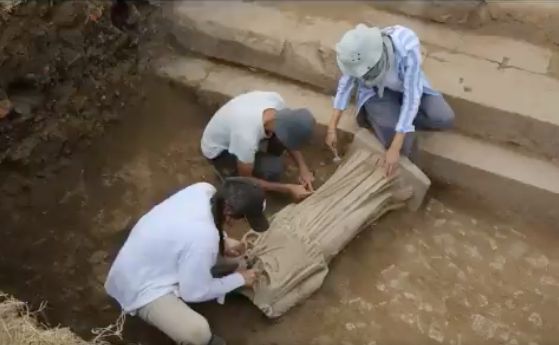ART WORLD NEWS
1,800-Year-Old Statue Found in Ancient “City of the Mother Goddess” in Turkey
Archaeologists in Turkey have uncovered an 1,800-year-old statue in the ancient city of Metropolis, known as “City of the Mother Goddess.” The marble figure of a robed woman standing on a pedestal is missing a head and both arms—which were likely attached separately—but is otherwise well preserved. The Turkish Culture and Tourism Ministry’s Department of Excavations announced the news earlier this month, along with a video of their excavation work and views of the statue.
The city of Metropolis, where the statue was discovered, is located in the Torbali region of Turkey’s İzmir Province near the western coast of Turkey, between the ancient cities of Ephesus and Smyrna (modern-day İzmir). It was first settled in the Neolithic period (roughly 10,000 B.C.E. through 1900 B.C.E.), with later inhabitants arriving during the Classical, Hellenistic, Roman, Byzantine, and Ottoman eras.
Related Articles
During the Bronze Age (approximately 3300 B.C.E. to 1200 B.C.E.), Metropolis (then called Puranda) was part of the Hittite’s Arzawa kingdom. A seal bearing Hittite hieroglyphs that was discovered in the city’s acropolis, which was studied by Andreas Schachner and Recep Meriç in 2000, has yet to be deciphered.
In the Hellenistic period (323 B.C.E. to 31 B.C.E.), the area surrounding Metropolis was ruled by the kingdom of Pergamum. During this time, they built a temple to honor the Greek god of war Ares—one of only two temples from Pergamum dedicated to the god in existence today—and a restored ancient Greek amphitheater, where archaeologists uncovered a marble “seat of honor” flanked with griffins in 1995.
Excavations on the city of Metropolis have been ongoing for 30 years, with archaeologists finding over 11,000 artifacts dating to various historical periods, including coins, glass, ceramics, figurines, sculptures, and many bone, ivory, and metal artifacts. Notable finds within the city include elaborate Roman baths featuring sculptures of Thyke and Zeus, as well as gladiator figures, and four monumental cisterns in the acropolis that would have been large enough to hold 600 tons of water for the city. In addition to the temple and the amphitheater, a range of buildings have also been uncovered, from a sports complex to an assembly building, and various shops, avenues, galleries, and public toilets.
Further research on the statue is needed to determine its identity and purpose. The recent excavations are a collaboration between the Culture and Tourism Ministry and Celal Bayar University, which could not immediately be reached for comment, but plan to continue work at the site through this year.











